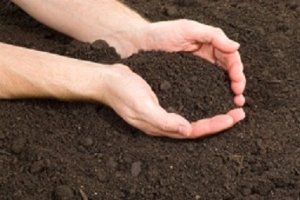All About Soil Testing!
![]()
![]()
![]()
 To test, or not to test—that is the question. Whether t’is nobler to suffer the slings and arrows of poor soil, or to have that soil tested, and, by amending its components, have a healthier garden. Soil tests were unavailable in Shakespeare’s day, but we in the modern age have no such excuse. Testing your soil is an easy, cost-efficient process whose benefits can yield tremendous results.
To test, or not to test—that is the question. Whether t’is nobler to suffer the slings and arrows of poor soil, or to have that soil tested, and, by amending its components, have a healthier garden. Soil tests were unavailable in Shakespeare’s day, but we in the modern age have no such excuse. Testing your soil is an easy, cost-efficient process whose benefits can yield tremendous results.
Before rushing out to your home and garden center, however, you’ll want to do a few simple tests on your own. First of which: determine your soil’s texture and profile. Soils are either clay-, sand-, or loam-based. Clay soils are nutrient-rich but poor-draining, sandy soils have excellent drainage but little nutrition, and loamy soils are just right—good nutrition and drainage. But while loamy soil is generally ideal, certain plants prefer more sandy or clayey soils. Plus, poor drainage can be the death of certain plants, so make sure you’re striking the right balance.
You’ll also want to conduct an ‘earthworm census’. Being as they are indicators of soil health, earthworms are something you want to see a lot of. Take a 1 by 1 cylindrical cross sample of your soil, and sift through it. Ten worms or more means you’ve got healthy soil. Less than that means your soil is either lacking in organic matter or is too acidic or alkaline.
Speaking of acidity and alkalinity: checking your soil’s Ph level is yet another crucial step to take. Because most plants prefer a neutral Ph (around 6 or 7 on a scale of 0 to 14), you’ll want to make sure your soil is neither too acidic nor too alkaline. Now’s the time to head to the home and garden center. You can get a PH test kit for as little as $4. If your soil turns out too acidic, you’ll want to add lime; if it’s too alkaline; you’ll want to add sulfur.
 If you’ve done the above and are still struggling, take a sample of your soil to a local cooperative or lab to have it analyzed. Labs typically formulate their recommendations towards farmers, so be sure to remind them that you’re a gardener. They can test for phosphorous, potassium, calcium, sulfur, and magnesium levels. (Nitrogen is not usually tested because the content in your soil can change dramatically and quickly). Zinc, iron, copper, and other micronutrient levels can also be tested.
If you’ve done the above and are still struggling, take a sample of your soil to a local cooperative or lab to have it analyzed. Labs typically formulate their recommendations towards farmers, so be sure to remind them that you’re a gardener. They can test for phosphorous, potassium, calcium, sulfur, and magnesium levels. (Nitrogen is not usually tested because the content in your soil can change dramatically and quickly). Zinc, iron, copper, and other micronutrient levels can also be tested.
So what are you waiting for? Grab yourself a trowel and get testing!
